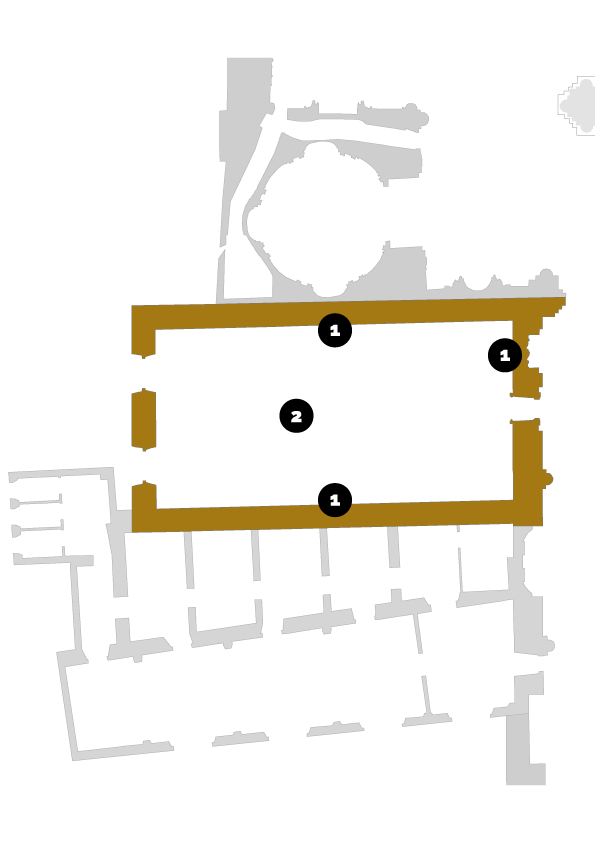To honour the memory of his maternal uncle Aeneas Silvius Piccolomini (Pope Pius II)and to preserve the rich collection of books and manuscripts that that humanist pope had put together while in Rome, Cardinal Francesco Todeschini Piccolomini, archbishop of Siena and himself subsequently elected to the papacy with the title of Pius III, commissioned the construction of a library in circa 1492, on the area formerly occupied by the priest’s house parallel to the northern wall of the Cathedral. Todeschini took his inspiration from the French tradition of having libraries attached to cathedrals and from the inauguaration of the Vatican Library by Pope Sixtus IV, a move which embodied the Renaissance ideal of creating an institution that was at once a centre of scholarship and an artistic expression of the “modern era”. The frescoes adorning the library were painted by Pinturicchio and his workshop between 1503 and 1508. They celebrate the life and work of Pius II and his pontificate, with a wealth of atmospheric landscapes and real and imaginary costumes, sophisticated ceremonies and figures painted in a rich, enamelled palette.
frescoes and the sculptures
The splendour of living colour: paintings in the vault in the Classical style and ten stories illustrating the life of Pope Pius II
Frescoes
The glittering vault decorated in the “grotesque” style contains a series of allegorical figures, pastoral scenes, bacchanalia and marine thiasoi, two larger panels depict episodes from classical mythology (Diana and Endymion and the Rape of Proserpina) and the arms of Cardinal Todeschini Piccolomini – five crescents beneath a cardinal’s hat – loom large in the centre of the ceiling.
The frescoes showing Scenes from the Life of Aeneas Silvius Piccolominiunfurl on three of the Library’s four walls, the fourth wall consisting in windows. The “painted biography” method comprises scenes focusing on a single individual whose life is outlined in a series of salient episodes and events shown in strict chronological order. Thus the north-eastern wall of the Library has four scenes basically recounting Aeneas Silvius’ youth (the young man is portrayed with flowing blond locks) from his departure for the Council of Basle to the scene in which he is reconciled with Pope Eugene IV and subsequently ordained bishop. The two panels on the south-eastern wall show Aeneas Silvius exercising his functions as a bishop and being made a cardinal. And the four scenes of the south-western wall depict episodes from his life as pope, stretching from his coronation to his Arrival in Anconawhere he surrendered his soul to God.
The Life of Pius II written by the humanist Giovanni Antonio Campano, who was secretary both to Aeneas Silvius and subsequently to his nephew Francesco Todeschini, and Pius II’s own Commentariiare crucial reference works for the origin of the individual scenes and for gaining a fuller picture of Aeneas Silvius’ life.
The fifth scene in the cycle depicta one of the better-known episodes, showing the meeting (in which the pope played a facilitator’s role) between the Emperor Frederick III and Eleonora of Aragon that took place by the city’s Porta Camollia gate on 24 February 1452. Pinturicchio dwells at length on the depiction of the fabrics, adornments and jewels worn by the figures gathered around the august bride- and bridegroom-to-be.
In the scene depicting the Canonisation of St. Catherine of Siena, the crowd of onlookers in monks’ and friars’ garb in the bottom left-hand corner includes two figures who have long been identified as the young Raphael(in red hose), who is reputed to have worked with Pinturicchio on the Library frescoes, and Pinturicchio himself (sporting a red cap).
Sculpture and illuminated manuscript codices
The marble group of the Three Graces (a Roman-era copy of a Hellenistic original) that Francesco Todeschini purchased from Cardinal Prospero Colonna in Rome stands in the centre of the Library. The 19th century floor is made up of rhomboid tiles manufactured by the Ginori porcelain works to replace the original smaller triangular tiles, some of which are now in storage with the Museo dell’Opera while others have found their way into various museums’ collections. The showcases around the walls contain a magnificent series of illuminated manuscript codices (Graduals and Antiphonaries) that form a collection offering an almost complete overview of the history of Italian illumination in the 15th century. In addition to the work of Sienese artists, the most precious pages are those illuminated by Girolamo da Cremona and Liberale da Verona, both of them famous illustrators summoned from northern Italy to produce these illuminations in the late 1460s.
GROUND PLAN OF THE LIBRERIA PICCOLOMINI
Position of the masterpieces inside the Libreria Piccolomini:
1 Episodies in the life of Pius II – Bernardino di Betto known as the “Pinturicchio
2 The Three Graces – Roman copy of Hellenistic original
OPENING TIMES LIBRERIA PICCOLOMINI
From 26 December to 7 January 2025
10:00 am – 7:00 pm
Public Holidays: 1:30 am – 5:30 pm
From 8 January to 30 March 2025
10:30 am – 5:30 pm
Public Holidays: 1:30 am – 5:30 pm
From 31 March to 02 november 2025
10:00 am – 7:00 pm
Public Holidays: 1:30 am – 6:00 pm
From 3 November to 24 December 2025
10:30 am – 5:30 pm
Public Holidays: 1:30 am – 5:30 pm
On December 1st, because of the Patron Saint, the Cathedral will be open from 10.30 am to 3.00 pm, with last admission at 2.30 pm. The rest of the complex will be open until 5.00 pm (last admission 4.30 pm).
From 26 December to 6 January 2026
10:00 am – 7:00 pm
Public Holidays: 1:30 am – 5:30 pm
DURING UNCOVERING THE FLOOR
From 27 June to 31 July and from 18 August to 15 October 2025
10:00 am – 7:00 pm
Public Holidays: 09:30 am – 6:00 pm
Last admission 30 minutes before closing time.
The Gate of Heaven ticket can be purchased exclusively online or at the ticket office based on remaining availability.
CALL CENTER
Information, reservations and ticket sales
+39 0577 286300
TICKETS
Immediate access to the masterpieces of the Monumental Complex of the Duomo, reducing waiting times
A SINGLE TICKET THAT ALLOWS ACCESS TO THE CATHEDRAL ROOFS AND TO ALL THE MUSEUMS OF THE COMPLEX
FULL PRICE
01/04 – 06/01: € 21,00
REDUCED TICKET (CHILDREN FROM 7 TO 11 YEARS OF AGE)
01/04 – 06/01: € 6,00
FREE (CHILDREN UP TO 6 YEARS OF AGE)
Remember to always consult the rules of conduct before accessing the tour.
A SINGLE TICKET THAT ALLOWS ACCESS TO ALL THE MUSEUMS OF THE COMPLEX.
Valid for three consecutive days from the date of issue.
FULL PRICE
01/01 – 26/06; 01/08 – 17/08; 16/10 – 31/12: € 14,00
during floor uncovering
(27/06 – 31/07; 18/08 – 15/10): € 16,00
REDUCED TICKET (CHILDREN FROM 7 TO 11 YEARS OF AGE)
01/01 – 31/12: € 3,00
FREE
- Children up to 6 years of age
- Siena municipality residents and born
- Journalists
- Disabled visitors (+ one carer per visitor)
- Clerics of both genders
- Students of University of Siena and University for Foreigners of Siena
- Parish groups of the Archdiocese of Siena with a letter from the parish priest
THE CULT
The Duomo is by definition the house that welcomes the Christian community gathered for liturgical celebrations. Therefore the Cathedral is always accessible to the faithful for prayer through the Door of Forgiveness.
HOLY MASS TIMES
Weekdays: 9:30 am (Chapel of Our Lady of the Vow)
Holidays and days before holidays: 8:00 / 11:00 / 12:15 / 18:00 (Summer 18:30)
In the periods when the floor is uncovered, Holy Masses are celebrated in the church of the Santissima Annunziata:
Weekday: 9:30 am Holidays: 8:00 am – 6:30 pm
For times on the occasion of solemnities or special events see the news section.
* Those born and resident in the Municipality of Siena have free access to the entire monumental complex of the Duomo





